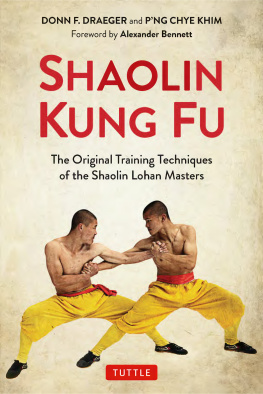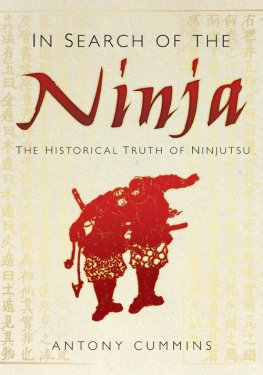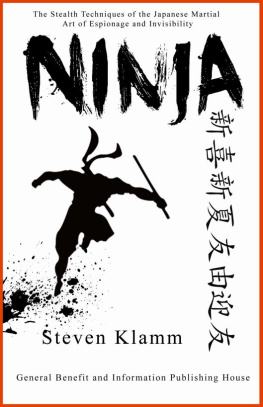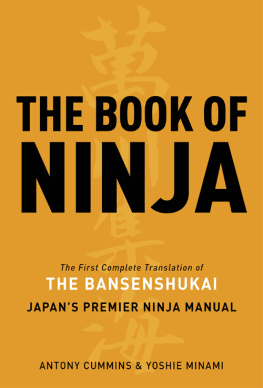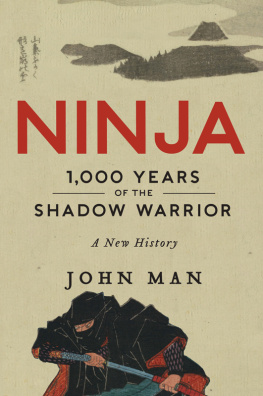

FACTS, LEGENDS, AND TECHNIQUES
TUTTLE PUBLISHING
Tokyo Rutland,Vermont Singapore
Disclaimer: Please note that the publisher and author of this instructional book are NOT RESPONSIBLE in any manner whatsoever for any injury that may result from practicing the techniques and/or following the instructions given within. Martial Arts training can be dangerousboth to you and to others if not practiced safely. If you're in doubt as to how to proceed or whether your practice is safe, consult with a trained martial arts teacher before beginning. Since the physical activities described herein may be too strenuous in nature for some readers, it is also essential that a physician be consulted prior to training.
Published by Tuttle Publishing, an imprint of Periplus Editions (HK) Ltd., with editorial offices at 364 Innovation Drive, North Clarendon, Vermont 05759 U.S.A.
Copyright 1989 Donn Draeger
All rights reserved. No part of this publication may be reproduced or utilized in any form or by any means, electronic or mechanical, including photocopying, recording, or by any information storage and retrieval system, without prior written permission from the publisher.
Library of Congress Control Number: 89-50021
ISBN: 978-1-4629-0323-8 (ebook)
Distributed by
North America, Latin America & Europe
Tuttle Publishing
364 Innovation Drive
North Clarendon, VT 05759-9436 U.S.A.
Tel: 1 (802) 773-8930 Fax: 1 (802) 773-6993
www.tuttlepublishing.com
Asia Pacific
Berkeley Books Pte. Ltd.
61 Tai Seng Avenue #02-12
Singapore 534167
Tel: (65) 6280-1330 Fax: (65) 6280-6290
www.periplus.com
10 09 08 07 5 4 3 2 1
Printed in Singapore
TUTTLE PUBLISHING is a registered trademark of Tuttle Publishing, a division of Periplus Editions (HK) Ltd.
CONTENTS
INTRODUCTION
The Consummate Secret Agent
by Boy Lafayette De Mente
The activities of spies, espionage agents, assassins, terrorists and counterterrorist forces are now regular news throughout most of the civilized world. These agents of death and destruction often utilize scientific technology that makes some of their feats seem almost supernatural.
Many of the professionals in this nefarious and inhuman business learned some of their methods from studying the strategy, tactics and weapons of Japan's infamous feudal-age ninja who practiced the arts of ninjutsu. and were probably the best trained, most ingenious and deadliest undercover agents of all time.
The roots of ninjutsu have been traced to the Chinese military classic Sun Tzu, written by the famed strategist Sun Tzu who lived around 400 B.C. The work was introduced into Japan in the 6th-century-A.D., where it was carefully studied by the Imperial Court and various clan leaders vying for power.
Buddhism was introduced in Japan at about the same time, resulting in a conflict between those who wanted to make Buddhism the state religion and the defenders of Shintoism, the native religion.
The predecessors of Japan's ninja were so-called rebels favoring the adoption of Buddhism who fled into the mountains near Kyoto as early as the 7th-century-A.D. to escape religious persecution and death at the hands of Imperial forces.
These rebel groups came to be known as yamabushi or mountain ascetics, who sought enlightenment through pragmatic mysticism. To protect themselves, they combined the study and practice of martial arts and military strategy with psychological warfare and occult powers.
A noted Yamabushi leader began trying to implement a compromise between the backers of Buddhism and the Shintoists, resulting in the Imperial Court sending warriors to invade the mountain domains of the rebels. The attempt to wipe them out failed.
The threat from the Imperial Court continued, however, and over the centuries the yamabushi developed extraordinary survival and fighting skills that made them formidable enemies. By the beginning of Japan's feudal age in 1192, a number of family-clans descended from these rebels had become professional guerrillas and secret agents for hire, and were often retained by the various provincial lords (daimyo) in their inter-clan struggles for supremacy.
Between 1192 and 1333 A.D., a total of 25 ninja schools developed, each with its own distinctive techniques and specialties. Ninja training camps flourished throughout the country. During most of this period two of Japan's provinces (now called prefectures) were dominated by ninja clans.
There were more than 50 families in the Koga school of ninja in Koga province (now Shiga Prefecture), but only three ninja families, the Hattori, the Momochi and the Fujibayashi, controlled Iga province (now Mie Prefecture). These three were the most famous of feudal Japan's ninja families, the largest of which had over 1,000 members.
THE GREATEST NINJA BATTLE
The largest recorded gathering of ninja took place on November 3, 1581 when Oda Nobunaga, the most powerful clan leader of the time, led an army of 40,000 warriors against approximately 4,000 Iga ninja in the mountains of Iga province. Only a few of the Iga ninja escaped with their lives.
A short time later, Oda was assassinated by one of his own aides. Oda's leading general, Ieyasu Tokugawa, immediately began moving to consolidate power in his own hands. He retained the famous ninja leader Hattori and his men to escort him back to his headquarters Okazaki. Later Ieyasu employed the Hattori ninja as his personal bodyguard, giving them the cover of gardeners on the castle grounds.
In a further move to protect himself and the Shogunate he founded, Ieyasu employed large numbers of the Koga ninja clan in his own secret service. Shortly after this he also brought ninja from other family-clans into the new Shogunate security forces.
As part of his far-reaching plan to solidify and perpetuate the Tokugawa Shogunate, Ieyasu then banned all ninja training camps except those that were to serve the Shogunate, and even prohibited the mention of the deadly secret agents in any public reference.
In 1637, Ieyasu's grandson and successor, Iemitsu, used several hundred ninja from the Iga clan to help the Shogunate army capture and slaughter some 40,000 Japanese Christians who had taken refuge in a castle in Shimbara. This was to be the last major military action in which ninja played a vital role.
The ninja-turned-Shogunate-security agents and their descendants continued to dominate the police force in Edo (Tokyo) and other Japanese cities down to the 19th century, using their techniques and tactics to identify and capture criminals and enemies of the Tokugawa Shogunate.
Without the intrigue and military competition that existed between Japan's some 270 clan lords (daimyo) and the Shogun before the establishment of the Tokugawa period, the fortunes of the outside ninja families declined rapidly.
Ninja who were not able to make the transition from secret agents to policeman or government security agents sometimes became outlaws and master criminals. The famous robber Goemon Ishikawa, often referred to as the Robin Hood of Japan, had been a ninja lieutenant in the Momochi clan. He was finally captured by Shogunate agents and executed by being boiled alive in a huge cauldron.
Following the downfall of the Tokugawa Shogunate in 1868, the government-sponsored ninja schools were closed down, but several ninja masters continued to practice and teach privately over the next several decades. By the mid-1900s there were only a few descendants of these families who remembered the old skills, and attempted to carry on some of their traditions as peaceful martial arts. The history and traditions of the ninja are commemorated in a Ninja Museum in Iga-Ueno in present-day Mie Prefecture.
Next page




